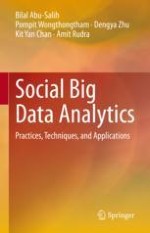
2021 | OriginalPaper | Chapter
1. Social Big Data: An Overview and Applications
Authors : Bilal Abu-Salih, Pornpit Wongthongtham, Dengya Zhu, Kit Yan Chan, Amit Rudra
Published in: Social Big Data Analytics
Publisher: Springer Singapore
Activate our intelligent search to find suitable subject content or patents.
Select sections of text to find matching patents with Artificial Intelligence. powered by
Select sections of text to find additional relevant content using AI-assisted search. powered by